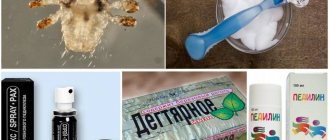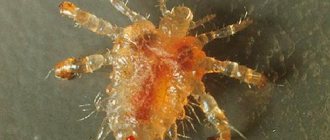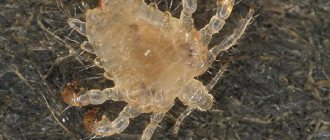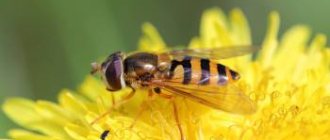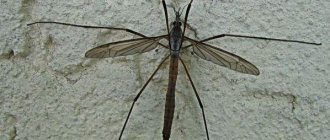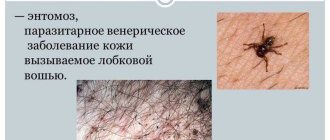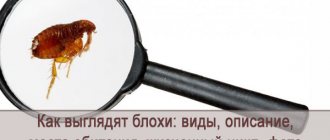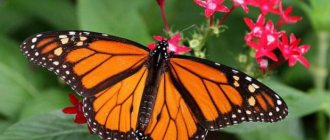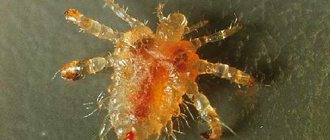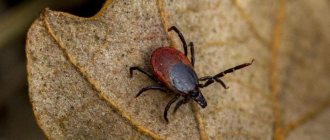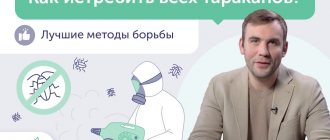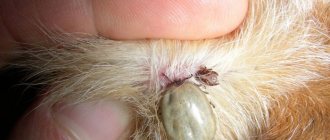- about the author
- VK profile
Svetlana Tarasova
Hairdresser-stylist with more than 8 years of experience, expert in the field of haircuts, styling, hair care, coloring.
Lice are arthropod insects that cause a parasitic skin disease - pediculosis. This disease is the most common among people and regardless of the economic level of the country. According to Rospotrebnadzor, about 300 thousand cases of the disease are recorded in Russia every year.
Types of lice
Before considering the question of what head lice look like, it is necessary to understand their classification.
In total, there are 3 types of these parasites: head, underwear (clothes) and pubic. Linen lice reproduce and lay eggs exclusively on human clothing or bedding. They move onto the “host’s” body only to feed. Their paws are not designed to live on hair, which cannot be said about their heads. Removing them is quite simple - you need to wash bedding and clothes with a special detergent. The habitats of pubic lice are clear from their name. They are rarely found on men's facial hair and eyelashes.
How long do they live
The maximum lifespan of lice is 2 months. Insect lifespan:
- head lice – 4 weeks;
- body lice – 46 days (in females) and 32 days (in males);
- pubic lice – 20 days (females), 22 days (males).
Lice can live in water for up to two days, and their eggs can live for 3 days. And without food, lice have a short lifespan - about 2 days. Hatched larvae, without access to food, die after 12-48 hours.
What do head lice look like?
These small parasites can live and reproduce exclusively on the human body. They predominantly have a gray body color, but in adults it can vary depending on the hair color of the “owner”.
The body of females is slightly elongated and measures about 4 mm. Males are much smaller in size. These insects have 6 legs with hooks located at the ends. Thanks to the latter, they are well attached to the hair and crawl along it unhindered. Insects amaze with their activity. For example, in a minute they can crawl a distance of 25 cm. Head lice are characterized by high fertility. Therefore, in the absence of timely treatment, their number rapidly increases several times.
Adults attach their eggs, called nits, to the hair roots. After about 8-10 days, nymphs emerge from them. This is a transitional stage between eggs and adults. After another 10 days, the nymphs grow completely. From this moment on, they can lay eggs on their own.
Parasites feed on human blood. They obtain it by biting the scalp. These places immediately begin to itch and itch.
Traditional methods of treatment
There are a huge number of ways to get rid of head lice using traditional methods:
- • treatment with vinegar diluted in water;
- • applying a mixture of garlic and onion to the hair;
- • use of cranberries or cranberry juice;
- • treatment of the head with kerosene
- • washing your hair with laundry or tar soap;
- • applying hair dye to hair;
- • treatment with alcohol.
Folk remedies have a number of disadvantages. Most of them cannot get rid of lice completely, so they require repeating the procedure several times. Some of them (for example, kerosene) can be dangerous and cause poisoning or scalp burns.
Life cycle
The head louse spends its entire life on the scalp. If the parasites leave the “host” body for some reason, they die within 1-2 days. They cannot exist on animals.
The development cycle is 30-40 days. During this time, the louse manages to lay about 200-300 nits. Externally, the eggs are similar in size and color to sesame seeds. The female attaches the larva approximately 5 mm from the surface of the skin. During the time it takes for young individuals to hatch from eggs, the hair has time to grow a little. Therefore, nits located more than a centimeter from the skin are usually empty. With each new offspring, lice reproduction becomes more spontaneous.
The life cycle of head lice varies depending on temperature, hair length and the presence of skin diseases. For example, on short hair the parasite cannot deposit a large number of nits. Therefore, reproduction takes longer. The presence of dermatological diseases on the scalp, accompanied by the formation of a crust, also stops this process. At temperatures below +10 degrees, insects can survive without food for no more than 10 days. For example, at a temperature of 32 degrees they die without food on the fourth day. Thus, how long head lice live without humans depends largely on environmental conditions.
Answers to popular questions
Given the high risk of developing head lice, many are interested in a number of questions related to the life activity of ectoparasites.
How quickly do lice grow and how many days do they multiply? The development time of the parasite from nit to adult is 18-23 days. During this period, the larvae overcome all phases - they become adults, are distributed over different parts of the human head and begin to bite it painfully. The development of the pest occurs very rapidly. After 15-17 days, the new louse can lay eggs on its own.
The development of louse is a complex process that requires certain conditions. But despite this, ectoparasites are still a significant problem for humans.
Therefore, the destruction of pests must be carried out from the moment they are detected. To do this, insecticides are used, which quickly and effectively help get rid of not only adults, but also larvae.
Distribution routes
Head lice are predominantly found in children and adults with long hair. They are transmitted through personal hygiene products, such as combs or hair ties.
Parasites can appear even in clean people who live in good conditions. They are caused by close contact with an infected person. Parasites pass from the “host” during games, sexual intercourse, wrestling, and accidental touching of the head.
Where do head lice in children come from? In children's groups, the spread of these insects occurs at lightning speed. They can be transmitted to healthy babies through shared towels or pillows, when bathing in the bathtub or wearing other people's hats. Therefore, a high risk of infection is observed in gardens and schools, swimming pools, hotels, and trains.
How long does it take for a louse to hatch?
These parasites are species-specific - they can feed on human blood and only human blood. Lice and nits have no other victims. Parasites bite and drink blood already from the nymph stage, and only an adult insect can reproduce. The first mating occurs only after the last molt and the first bite after that. To leave offspring, lice must constantly receive food. They drink blood every 3 – 4 hours. If they are left without food, they cannot reproduce. That's why it's important to start pest control right away so as not to give lice a chance to further increase the population.
Stages of their development:
- Nits are lice eggs. They ripen on average within 5 – 8 days. The period of egg development depends on external conditions, primarily on temperature. The temperature of the human body is considered the most favorable, so head lice lay eggs as close to the scalp as possible. In this case, lice hatch from nits within 5 days. When the temperature decreases or increases, the incubation period of nits increases. They stop their development, but do not die. And as external conditions improve, their development continues. In particularly severe cases, the larva can hatch after 16 days. If the nit somehow ends up outside the human body, then it can fall into a state of suspended animation. At this time, all vital functions in the larva are suspended.
- The first order nymph is the first stage of lice development. The larva reaches a size of 1.5 mm, which is larger than the size of a nit. She opens the egg and leaves it, then growth occurs for five days, after which the first moult occurs. The insect's shell does not keep up with its growth, so the parasite sheds it, increasing in size.
- The second-order nymph is the stage of the louse's life cycle between the first and second moults. It takes 5 – 8 days. During this time, the parasite increases significantly in size. At first the louse is 1.75 mm in size, and by the second molt it reaches 2 mm.
- Nymph of the third order - at this stage, the insect’s legs lengthen, the body becomes more elongated and exceeds 2.4 mm in length. After the third molt, the nymph turns into an imago, that is, an adult. For such a transformation she needs from 5 to 8 days.
The difference between an adult and a nymph is sexual maturity. An adult louse is able to reproduce on the second day after becoming an adult.
So, to answer the question of how long it takes for lice to appear in large numbers after contact with an infected person, you need to calculate the total development time. After the insect lays eggs, the new adult will begin to parasitize and produce subsequent generations within three weeks. Under ideal conditions, it takes 10 days from hatching from an egg to becoming an adult insect.
Above we talked about head lice. The life cycle of pubic lice is the same. Body lice develop a little more slowly. But in general, all types of lice go through the same stages of development. The difference is that linen lice lay eggs in clothes, underwear, towels, etc. There may not be such a favorable air temperature or humidity for the insect to develop in the shortest possible time. In addition, starting from the first nymph stage, the parasite can bite and suck blood. He needs food, so he goes hunting before reaching maturity. If it does not have a constantly available source of power, then its rate of development slows down.
How dangerous are parasites?
Insects do not carry dangerous diseases that are transmitted through blood. We are talking about AIDS, hepatitis and others.
However, diseases spread by human head lice include typhus. In the stomach of parasites, favorable conditions are created for the growth and further reproduction of individual microorganisms. These include the causative agents of typhus and relapsing fever. They are not transmitted to humans by a bite, as many people think. Infection occurs through excrement or when an insect is crushed. If there are small wounds and other injuries on the skin, the likelihood of developing typhus increases several times. Also, infection cannot be ruled out if the pathogen gets on the mucous membranes.
Pediculosis disease and its symptoms
Pediculosis is a disease caused by head lice. Its prevalence is quite high. Therefore, every person needs to know what symptoms to pay attention to first and what head lice look like.
The first sign of infection is severe itching. Its appearance is caused by an enzyme secreted by the parasite. Most people are allergic to it. At the initial stage, many people perceive itching as a reaction to shampoo or the development of a skin disease (for example, seborrhea). To determine the source of discomfort, you should pay attention to its location. If your head itches behind your ears, you can safely talk about lice. Head lice are clearly visible upon examination.
Another symptom is the presence of nits. Insect eggs are attached directly to the hair. They are white, which only simplifies the search. Sometimes they are confused with dandruff. However, nits are located on the head in the area closer to the neck. In addition, if you try to crush the parasite egg with your fingernails, a characteristic sound will be heard.
In advanced cases, the hair sticks together and tangles form. Due to constant scratching, the course of the disease may be complicated by furunculosis or other pustular lesions. In the absence of treatment, lymphadenitis develops, the lymph nodes in the neck and ears become enlarged and inflamed.
Pharmacy treatments
The principle of treatment for pediculosis is based on the elimination of lice and the prevention of their further reproduction. For these purposes, special preparations are used in the following forms:
- shampoos;
- aerosols;
- lotions;
- sprays.
Shampoos are considered less effective than those listed above. Their action is aimed at deep penetration into the body of the parasite, as a result of which the insects die. The most popular are “Pedilin” and “Parasidosis”. The product must be applied to damp hair and left for 10-15 minutes. After this, the shampoo should be washed off and the hair should be combed with a comb. This procedure should be repeated once a week. Anti-head lice shampoo should only be used as directed by a doctor. Pregnant and lactating women, as well as children under 3 years of age, should avoid using it.
How to get rid of head lice not only on your head, but also on your clothes? A variety of aerosols are suitable for these purposes (for example, “Para-Plus” and “A-Par”). Some of them are used exclusively for treating clothing, while others can be used to eliminate lice on hair.
Aerosol "A-steam" is designed to eliminate insects from clothing. The product does not leave stains on the material, and the treated items do not require subsequent washing. However, you cannot put them on right away. It is better to leave it to ventilate for several days. It is recommended to process clothes with the window open. If the product gets on the mucous membranes of the eyes, they should be rinsed immediately under running water. It is prohibited to use hair spray as it contains toxic substances. Also, it should not be sprayed near children, other people, asthma patients, or pregnant women.
Para-Plus is considered a safer remedy. The aerosol can be sprayed onto the hair and scalp. After the procedure, you need to shower using regular shampoo. Dead lice and nits should be combed out with a comb. To prevent re-infection, personal hygiene products, underwear and clothing can be treated with this product. The instructions do not recommend it for use by children under 2 years of age and persons prone to allergies.
Various sprays (Paranit, Nyuda, Pediculen Ultra) are good against parasites. The listed drugs have proven themselves to be positive and are highly effective. They are a yellowish oily liquid. It has no characteristic odor. The action of such drugs is aimed at immobilizing insects and rapid death.
“Paranit” instructions recommend applying it to dry hair. After they become a little damp, the product should continue to be rubbed into the roots of the hair. In the case of long curls, they must be combed in separate strands. The applied drug is left for 15 minutes, after which it is washed off with regular shampoo. Dead lice and nits should be combed out with a comb. After this, the head is washed again with Paranit shampoo. If necessary, the procedure should be repeated every 10 days. This product is not recommended for use by pregnant and lactating women, children under 3 years of age and people with dermatological diseases.
Spray "Nuda" has a similar effect. It should also be applied to dry hair and rubbed into the roots. However, you must leave the product on for at least 45 minutes. After time, the remaining spray is washed off with shampoo, and dead parasites are combed out with a comb. The latter is sold together with the drug "Nyuda".
Conditions of death
Insects do not tolerate cold well. They can easily withstand temperature drops to zero, but at temperatures below 20 °C they die within 30 minutes. Capsules with larvae maintain performance at a normal level.
A parasite can die from cold only if it is separated from the host’s body. Therefore, to combat body lice, wet clothes are hung out in the cold.
The optimal temperature for the proliferation of parasites on the body is 30 °C. If there is a significant deviation from this °C indicator, females stop laying eggs, and the development of nits slows down. When the figure reaches +45–50 °C, adults die within half an hour, but the eggs remain viable.
The larvae are protected by a durable shell, so they are not afraid of normal exposure to low or high temperatures. They also continue to gradually develop after they enter the water. To destroy them, it is necessary to create conditions under which the nits will find themselves in a stressful situation due to sudden changes in their habitat. This method is used to treat clothes and linen against body lice: they are ironed or boiled.
At what temperature lice and nits die, you can find out on our website.
Important! Changing the temperature regime is not suitable for getting rid of parasites that live on the human body. In this case, the best way to create unfavorable living conditions for lice is to use special products.
Insecticides
Insecticides are chemical substances designed to kill various insect pests. They usually paralyze the animal's nervous system, which ensures its rapid death. But there are remedies that work differently: they deprive parasites of the ability to breathe. Preparations of the second type cannot harm nits in any way, so they are used as one of the components of the complex.
Vinegar
Acetic acid is a popular folk remedy for lice control. Mixed with water, it dissolves the substance with which the egg capsules are attached to the hair.
The acetic environment is also unfavorable for adults. They do not die, but lose the ability to hold on tightly. After such treatment, it is easy to get rid of parasites and their clutches during combing.
Insects are also afraid of other organic acids: cranberry, lemon, grape juice.
Kerosene
Kerosene was used to remove lice in times when there were no safer options. It was applied to the infected hair, a plastic bag was put on top and left for 30 minutes. Kerosene poisoned the adults and partially dissolved the capsules of the larvae, which is why they could not continue to develop normally.
Smells
Using their sense of smell, parasites find a source of food, a mate for procreation, so they are sensitive to pungent odors. You can take advantage of this weakness by adding essential oils to your body and head treatments. Best suited for these purposes:
- tea tree;
- rosemary;
- mint;
- lavender;
- menthol;
- cypress;
- eucalyptus;
- bergamot.
You can add up to 5 drops of essential oil to shampoo or water for rinsing your hair, and no more than 1-2 to products intended for application to the body. The strong smell will not kill the insects, but will make them rather lethargic so that combing them out will bring maximum benefit.
Read on our website which natural oils are effective against lice and nits
The easiest way to create an environment unfavorable for pubic lice is to shave off the hair on which they live. This method is also suitable for getting rid of parasites that live on the head, but modern medicine offers many means that allow you not to make such a sacrifice.
Effective shampoos against lice and nits:
- Paranit;
- Veda and Veda-2;
- Nix;
- Hygia;
- Pediculen ultra;
- Nit Free (Nit Free);
- Does tar shampoo help against lice and nits?
Help from traditional medicine
Sometimes it is not possible to eliminate pediculosis with pharmaceutical products. We are talking about infection during pregnancy or lactation if lice were found in a child under 3 years of age. In this case, it is recommended to use traditional medicine methods. Sometimes more than one treatment procedure may be required, but these methods are completely safe for humans.
The most popular recipes are listed below:
- Tar soap. Apply the product to clean hair, distributing it evenly over the entire length. Particular attention should be paid to the area behind the ears. You need to put a bag on your head and cover it with a towel on top. After an hour, the hair should be thoroughly rinsed under running water and dried. Comb your hair with a comb to remove parasites and their eggs. The procedure can be repeated until complete recovery. In addition, it is recommended to wash the bed linen and clothes of the infected person with tar soap.
- Hellebore water. It is believed that this is the most effective remedy for nits and lice. It is made from the poisonous Lobel hellebore plant, which grows in Eurasia. Using a cotton swab, apply the product to all hair. They must be clean and dry. You then need to put a cap or bag on your head for 30 minutes. After this, rinse your hair well and comb it with a fine-toothed comb.
- Kerosene. This remedy has been used for a long time in the fight against parasites. It is believed that head lice cannot tolerate kerosene. It should be used carefully to avoid burns to the skin. To prepare, you will need to mix a tablespoon of kerosene and shampoo, apply to your head and leave for an hour. Then wash your hair with shampoo, dry it and comb it with a comb. The procedure can be repeated once a week.
- Vinegar. This is another popular remedy used at home to eliminate lice. As with kerosene, it is important to take precautions to prevent burns. You will need 9% table vinegar diluted with water in a 2:1 ratio. Soak a towel in the solution and gently soak your hair in it, avoiding contact with the skin. Place the bag on your head for an hour. Then wash your hair with shampoo, dry and comb with a comb.
It is customary for young children to have their heads cut. Of course, shaving is a rather radical method. However, it allows head lice to be deprived of an environment for feeding and reproduction.
Mechanical removal of lice
In addition to pharmaceutical and folk remedies for the treatment of pediculosis, there is also a mechanical method.
Just a few decades ago, it meant manually removing nits and lice from hair. However, today this method is practically not used. It was replaced by a special comb. It is equipped with fine teeth, the structure of which allows hair to pass through and trap parasites, their larvae and eggs. The scalp is not damaged. The use of such a comb in conjunction with pharmaceutical shampoos or folk remedies only enhances the effectiveness of the therapy.
You can also purchase an electric version. The action of such a comb is based on electrical impulses. They are harmless to humans, but deadly to insects. An electric comb is best used to remove lice from a child. It has much fewer teeth than the classic version. However, this is compensated by high efficiency. Under the influence of impulses, the parasites die, after which they can be safely washed away with water.
Prevention methods
Preventing head lice is quite simple. It comes down to observing basic rules of personal hygiene. Those with long hair are advised to wear a ponytail or tuck their hair under a hat when using public transport. You should also not use extraneous hats, towels, hygiene items, or combs.
If infection cannot be avoided, it is necessary to prevent the further spread of head lice. Bed linen, towels, and hats should be boiled and ironed. How to treat an apartment for head lice? To do this you need to use special tools. They are sold in hardware stores.
After infection, it is important to undergo examination by a dermatologist, who will prescribe therapy, and notify contact persons in the garden, school, and relatives about the disease. The recovery process should be regularly monitored by a specialist.
When should you see a doctor?
Over the past decades, lice have developed resistance to the chemicals used to remove them. In rare cases, lice can transmit typhus or fever, but advanced cases can cause pyoderma and purulent skin lesions. To prevent this, at the first sign of lice detection, you need to contact your local physician.
Do you see a doctor if you are diagnosed with lice?
Not really
Complications of pediculosis:
- conjunctivitis;
- inflammation of the edges of the eyelids;
- inflammation of the lymph nodes;
- streptococcal infections;
- bacterial infection (pyoderma) of the face, behind-the-ear areas and scalp;
- typhus (rare).
The doctor will determine the type of lice parasitizing on humans and select the optimal treatment . In addition, the incubation period of head lice is a month. And being in a group with a large number of people can provoke an outbreak of head lice, since the symptoms are not immediately noticeable.
The louse, as an insect, is very interesting for scientists to study. But for people it poses a danger of contracting lice. To avoid illness, you need to regularly carry out hygiene procedures, not use other people’s hygiene items and regularly wash your bed linen. In this case, the risk of infection is reduced to zero. And you don’t have to study the insect on your comb; it’s better to leave this to the specialists.
- about the author
- VK profile
